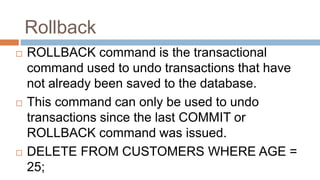DBMS Notes: DDL DML DCL
- 1. B.Tech III Sem ‘A’ DATABASE MANAGEMENT SYSTEMS
- 2. Topics Covered Database users Database Architecture DDL DML
- 3. Student Std_ID Name Addr Sec DoB Std_ID Name Addr Sec DoB 189X1A05XY Sree Sanfransisco A 01/01/1999 189X1A05XZ Sri Germany B+ 01/01/2000 ER Model Relational Model ER Model Vs. Relational Model
- 4. Naive / Prgmers / Sophisticated / DBA Appl. interface s Appl. programs Query tools Admin tools Query Processor Object code Compiler DML Queries DDL Interpreter Query Evaluation Engine Storage Manager Buffer Manager File Manager Authorization & integrity manager Transaction Manager Data Indice s Data Dictionar y Disk Storage Users
- 5. DDL Commands DDL: Data Definition Language CREATE ALTER DROP RENAME DML: Data Manipulation Language INSERT UPDATE DELETE SELECT DCL: Data Control Language GRANT REVOKE COMMIT (TCL) ROLLBACK (TCL)
- 6. DDL: Create CREATE TABLE CUSTOMER1( ID Number(2), NAME NVARCHAR2 (20), AGE INT, ADDRESS NVARCHAR2 (30) , SALARY DECIMAL (10, 2) create table cust_temp as select id, name from customer1; CREATE TABLE STUDENT2 ( ID INT NOT NULL, NAME VARCHAR(20) NOT NULL, AGE INT NOT NULL,
- 7. DDL: Alter ALTER TABLE table_name ADD column_name datatype; ALTER TABLE table_name DROP COLUMN column_name; ALTER TABLE table_name MODIFY COLUMN column_name datatype; ALTER TABLE table_name MODIFY column_name datatype NOT NULL;
- 8. DDL Command: DROP & Rename Drop table student; Rename student1 to student2; TRUNCATE TABLE customer1;
- 9. DML: Data Manipulation Language INSERT UPDATE DELETE SELECT
- 10. DML Example: Insert insert into customer1values(90, 'Codd',60,'San Fransisco', 150000); insert into customer1 values(&id, '&name',&age,'&address',&salary); SELECT * FROM EMPLOYEE UPDATE Customer1 set ID=18, WHERE Name='henry korth';DELETE FROM Customer1 WHERE Name='Henry Korth' AND age=60;
- 11. Today’s Topics DCL Entity Relationship Model Basic concepts Cardinality of Relationship ER Diagram Notations ER Diagrams: Examples
- 12. DCL: Data Control Language GRANT : used to grant or give the privileges. REVOKE : used to avoid or object the privileges. COMMIT: used to save the data permanently. ROLL BACK : Used to revert changes in the transactions since the last commit or rollback command was issued
- 13. DCL: Commit DELETE FROM CUSTOMERS WHERE AGE = 25; SQL> COMMIT;
- 14. Rollback ROLLBACK command is the transactional command used to undo transactions that have not already been saved to the database. This command can only be used to undo transactions since the last COMMIT or ROLLBACK command was issued. DELETE FROM CUSTOMERS WHERE AGE = 25;
- 15. DCL : Grant & Revoke create user korth identified by henry Connect as system/ora10g GRANT SELECT, INSERT, UPDATE, DELETE ON Emp_Det TO korth; REVOKE DELETE ON Emp_details FROM
- 16. Entity Relationship Model The ER data model facilitates database design by allowing specification of an enterprise schema that represents the overall logical structure of a database. The E-R data model employs three basic concepts: entity sets, relationship sets, and attributes
- 17. Entity Sets Entity: Real-world object distinguishable from other objects. An entity is described (in DB) using a set of attributes. Entity Set: A collection of similar entities. E.g., all employees. All entities in an entity set have the same set of attributes. Each entity set has a key. Each attribute has a domain.
- 18. Entity Sets
- 19. Relationship Sets Relationship: Association among two or more entities. A relationship set is a mathematical relation among n 2 entities, each taken from entity sets {(e1, e2, … en) | e1 E1, e2 E2, …, en En} where (e1, e2, …, en) is a relationship
- 22. Attributes An entity is represented by a set of attributes, that is descriptive properties possessed by all members of an entity set.Example: customer = (customer_id, customer_name, customer_street, customer_city ) loan = (loan_number, amount )
- 23. Attribute types Simple : Attribute is simple, if its value can not be divided into subparts. For example Std_ID, GPA. Composite : Attribute is composite, if its value can be divided into subparts. Ex: Name: First Name; Middle Name; Last Name Address: H.No; street; city; pincode Single-valued : Attribute is a single-valued, if it has only one value for a particular entity Multivalued : Attribute is multivalued, if it has a set of values for a particular entity. Ex: Phone number Derived: Attribute is a derived, if its value can be derived from the values of other related attributes or entities. Ex: Age, given dateofbirth
- 25. ER Diagram Notations Rectangles represent entity sets Ellipses represent attributes Diamonds represent relationship sets Lines link attributes to entity sets and link entity sets to relationships sets
- 26. Continued… ER Diagram Notations ER Diagram Examples


























